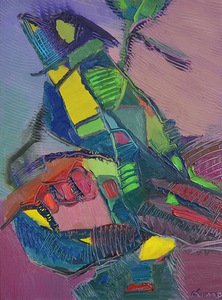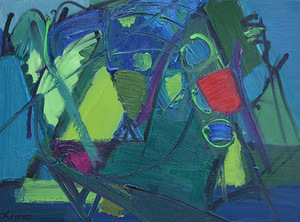Lina Morkūnaitė-Vilkelienė’s artistic language and play of spacetime 10
Last year I concluded my review about Lina Morkūnaitė-Vilkelienė’s work with the following: “The “contemplation” problem of painting arises from the complicated relationship between the author and the material, the author and another author, the author and tradition, etc. […] Lina’s painting goes in the direction of intuitivist aesthetics, where the language of art is determined by the unknown and the desired. […] The artist is trying to open the primary reality – a peculiar immersion of her soul into her own self. […] she looks into herself and in this way is coming closer to the primary characteristics of being, that is unfolding on the planes of her painting” (R. Venckus (2014). Open and moving paintings of Lina Morkūnaitė-Vilkelienė. Kaunas: gallery Balta).
One year later I do not renounce my observations. On the contrary, I would like to make an additional claim that the road the artist has been taking and the artistic program she has chosen have become more prominent. One year later Lina’s artistic language looks far more mature, remaining at the same time lively and positively sporadic (“Mask and Rabbit Ears”, acrylic on canvas, 100 х 81 cm, 2015; “Teapot and Wild Flowers”, oil on canvas, 60 x 81 cm, 2015).
I notice that the play of colours in the new collection has acquired more daring. The picture has become even more organic and at the same time intentionally out of control. Open colours dominate in some canvas, producing the impression that the colour autonomously marks its intentional resistance to reality. That means to say that the artist does not expect nor wishes to repeat the constructions of reality; she is turning away from the real world that is available to our eyes. Lina is constructing the mechanics of her own private world (“Abstraction. Nemajunai“, acrylic on canvas, 81 x 60 cm, 2014).
Thus the play of painting, developed by Lina, is like a peculiar pulsation of something that is impossible to name, but is alive. She is putting into image a different reality of the real. Painting that resists strict definitions looks like the most independent and autonomous system. Lina not only refuses a strict and dogmatic perception of reality, but creates images on canvas which come closest to dream (“Scenery of Padumbliai“, acrylic on canvas, 40 x 50 cm, 2015).
With the help of colour the artist also expresses unrestricted, primeval wish to feel and to perceive. Some strokes construct very fragile formal hints of the things that surround us, that is why it is possible to claim that the objects in the canvases do not come back into reality. They play in their separation, and we (the spectators) are merely attempting to find an intuitive dialogue with their past (“Newspaper Holder and Books”, acrylic on canvas, 81 x 60 cm, 2015). This is how the creator regards herself and the surrounding objects, approaching the “inner experience” and the inner invisible mechanics.
The discourse of inner experience cannot avoid the issue of time and space. Time and space in Lina’s painting are quite ephemeral and unstable. It seems that time is sliding away from the plane of the picture, inviting the spectator’s own free interpretational perception of it. The wide and “un-earthed” spaces, opening in the planes of the paintings, encourage me to imagine the places of artistic narrative in an unusual way (“Summer Scenery”, oil on canvas, 60 x 81 cm, 2015; “Sunset at the Lake Alausas”, oil on canvas, 60 x 81 cm, 2015).
Space and time are important for the artist, but they are also important for every one of us. Lina’s painting speaks about spaces that slip away and cannot be held, that are transformed from physical into sensual, and their analysis comes back again to the issues of “inner experience” and return to the primeval language (“Jailed”, acrylic on canvas, 100 x 81 cm, 2015).
Lina’s abstract painting tries to take us closer to another space, the one that might never come into existence, or the space that could not be “touched” by the usual human gaze (“Mask”, acrylic on canvas, 81 x 60 cm, 2015; “Touch“, acrylic on canvas, 81 x 60 cm, 2015). That is how Lina can extend time in one canvas, retracting it in another, distancing us from the real time, or presenting to us its decomposed fragments.
Abstract art segments time and moulds it into a collage play. Time shows up like a spectre: it is here and disappearing, it is somehow frightening and at the same time luring to experience it again. On the other hand, it is possible to say that the time of the artist is a time that is over, and the one that opens in front of us while we are watching the painting is a non-adequate, new time that breaks free from the canvas. This is where the charm of decomposed time comes from, it makes us watch Lina’s painting closely and meditate on her stroke and play of colour.
Finally, I would like to note that time is often defined by words “flow” and “change”. Flow suggests that time is sequential and linear, while change means faltering and even repetition. It is probably a mistake to think that change within the field of art cannot be related with real time and space, i.e., it cannot be clearly rendered in a two-dimensional work. Though painting does not possess time that is directly dependent on flow (e.g. flow is obvious in a film or in a theatre-play), yet time opens upon canvas through the planned change of flow. Every separate space of Lina’s canvas has an identifiable compositional focus (onto which the attention of the spectator is directed), and the separated spots of observation can be united into an integral viewing system.













